- Health & Well-Being
- Home Health Equipment
- Hospital Beds
- Independent Living
- Mobility
- Patient Care
- Pressure Care
- Sports Supports & Compression
Arthritis, a condition characterised by joint inflammation, can be a challenge for those who live with it. Everyday tasks like opening jars, gripping utensils, or even just walking can become daunting.
Fortunately, in this age of innovation, various aids for daily living (ADLs) have been developed to ease the burdens of arthritis sufferers.
This blog explores the myriad ways these tools empower individuals with arthritis to live fuller, more independent lives.
Before diving into the aids themselves, it's crucial to understand the implications of arthritis. Pain, stiffness, and reduced joint mobility are standard issues. The condition can turn simple activities — ones that many take for granted — into herculean tasks. But with the right ADLs, these challenges can be effectively mitigated.
Jar Openers: These tools are designed to give users added leverage, making the once painful task of opening jars a breeze.
Key Turners: A larger, ergonomic grip is added to keys, providing a more substantial area to grip and reducing the strain on finger joints.
Tap Turners: For those who struggle with turning faucets on or off, these tools offer extended levers to make the action smoother and less painful.
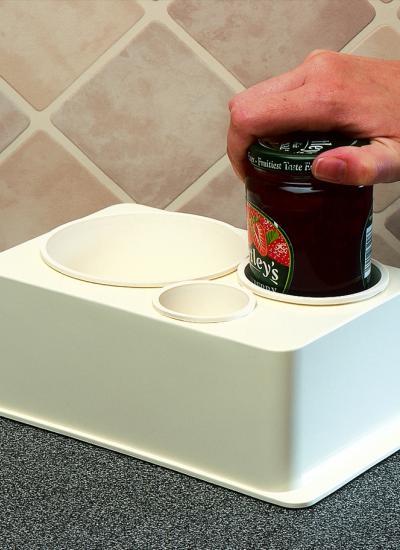
Button Hooks: Instead of struggling with small buttons, these hooks pull buttons through their holes using a simple mechanism, significantly reducing the required dexterity.
Zipper Pulls: This tool can be attached to regular zippers, offering a larger grip for easier use.
Shoehorns with Long Handles: Putting on shoes can be a challenge, especially for those with hip or knee arthritis. These extended shoehorns reduce the need for bending.
Elastic Shoelaces: These transform regular shoes into slip-ons, negating the need to tie and untie them.
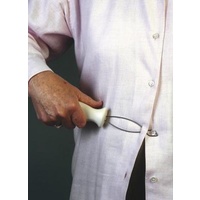
Kitchen Aids
The kitchen, a hub of activity and nourishment, can pose challenges for arthritis sufferers. However, with the right tools, these challenges can be managed, enabling them to prepare meals with ease and comfort.
Ergonomic Utensils: Forks, knives, and spoons with thicker, contoured handles allow for a more comfortable grip and decrease pain while eating.
Built-up Handled Food Preparation Utensils:
Good Grips Range: Renowned for their ergonomic designs, the Good Grips range offers a wide variety of kitchen tools, from peelers to knives. These utensils typically feature broad, non-slip handles that are easy to hold, even when wet. The soft material and unique shape provide cushioning and support to the hand, reducing stress on the joints.
Spike Boards: Prepping food often requires one hand to stabilise the item and the other to cut or chop. For those with arthritis, this can be particularly challenging. Spike boards come to the rescue here. These boards have small spikes to hold items like vegetables or fruits in place, allowing the user to cut or peel without needing to apply pressure to hold the item steady.
Pan Holders: These stabilise pans, reducing the need to grip with both hands while stirring.
Trolleys: Instead of carrying groceries or heavy pots, arthritis sufferers can place them on a trolley and push them to their desired location.
Introducing these specialised kitchen aids into the daily cooking routine can dramatically ease the strain of meal preparation for arthritis sufferers. The beauty of tools like Good Grips utensils and spike boards lies not only in their practicality but also in their ability to restore the joy of cooking. They ensure that the kitchen remains a place of creativity and nourishment, rather than a source of discomfort or frustration. With the right aids at hand, individuals with arthritis can continue to whip up their favorite dishes with flair and ease.
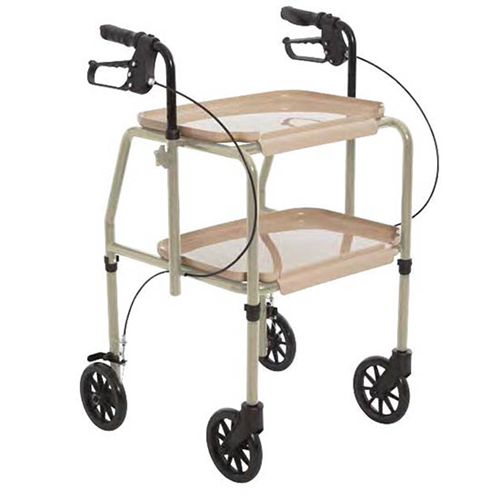
Walking Sticks and Crutches: These provide added stability. Opt for ones with ergonomic handles that distribute pressure more evenly.
Rollators: Equipped with seats, these wheeled walkers allow users to rest when needed, beneficial for those with arthritis affecting the legs or hips.
Personal Care Aids for Arthritis Sufferers
Personal care is an integral part of our daily routine, and for those with arthritis, even the simplest tasks can become daunting. However, the right aids can make these tasks not only manageable but also pain-free.
Extended Reach: The elongated handle of these sponges ensures that individuals can reach every part of their body, including the back, legs, and feet, without needing to bend or stretch excessively. This prevents undue strain on the spine, hips, or knees.
Ergonomic Design: Many long-handled sponges are designed with ergonomics in mind. The handle often has a non-slip grip, ensuring it doesn't slip out of wet hands. Some even come with a slight curve to match the contours of the back.
Reduced Joint Strain: The act of bending or stretching, especially in a wet, slippery environment like a shower, can be hazardous. By minimising this, the long-handled sponge not only offers comfort but also enhances safety.
Maintaining Independence: Being able to wash oneself thoroughly promotes a sense of independence and dignity. It's not just about cleanliness; it's about retaining autonomy in personal care.
Effortless Drying: Bending down to dry one's feet, especially the area between the toes, can be challenging for those with arthritis. Long-handled toe driers enable users to dry their feet and toes without needing to bend or crouch, reducing strain on the back, hips, and knees.
Absorbent Material: Typically made from highly absorbent material, these driers can quickly soak up moisture, preventing potential fungal infections or foot issues that can arise from dampness.
Safety Benefit: Thoroughly dried feet reduce the risk of slips and falls, especially on smooth surfaces like bathroom tiles.
Complete Cleanse: Similar in concept to the long-handled sponges, back washers specifically target the back area, ensuring a thorough cleanse without the need to stretch or strain.
Ergonomic Design: These washers often feature a slightly curved design to match the contour of the back, providing a comfortable and effective washing experience.
Durable Materials: Made from materials that resist the growth of mold or bacteria, they ensure a hygienic wash every time.
Long-Handled Brushes and Combs:
Ease of Use: Long handles on brushes and combs allow users to groom their hair without needing to lift their arms excessively high, reducing strain on the shoulders and elbows.
Comfortable Grip: Many of these brushes and combs are designed with non-slip, cushioned handles, ensuring they are comfortable to hold and don't slip during use.
Versatility: Available in a range of designs, from paddle brushes to round brushes and fine-tooth combs, they cater to different hair types and grooming needs.
Independence in Grooming: Looking presentable can give a boost to one's self-esteem and confidence. These aids ensure that arthritis sufferers can maintain their grooming routine, retaining a sense of normalcy and independence.
Work and Leisure Aids
Book Holders: These tools prop up books, reducing the need to hold them open, which can be painful for hands.
Adaptive Keyboards and Mice: For the tech-savvy, there are keyboards with larger keys and ergonomic mice designed for easier use.
Gardening Grips: For those with a green thumb, specialised grips can be added to gardening tools, making the beloved hobby more accessible and less painful.
The act of sitting and rising from a chair might sound trivial, but for someone with arthritis, it can pose significant challenges. Comfortable and supportive seating solutions can play a pivotal role in providing relief from joint pain and enhancing overall quality of life.
Ease of Use: One of the foremost benefits of recliner chairs is the ease they offer in transitioning between sitting and standing positions. Some recliners come with power lift mechanisms that can gently raise the chair, making it easier for the user to stand up without straining their joints.
Customizable Comfort: Recliner chairs often allow users to adjust the angle of inclination, ensuring a personalized comfort level. This ability to recline can be particularly beneficial for those with lower back, hip, or knee arthritis, as it allows users to elevate their legs and reduce pressure on painful joints.
Supportive Design: Many recliners are designed with ergonomics in mind, offering lumbar support and cushioning in areas that are prone to strain or pressure. This targeted support can provide much-needed relief from arthritis pain.
Heat & Massage Features: Some advanced recliner chairs come equipped with built-in heating pads or massage functions. Heat can help soothe stiff joints, while massage features can offer relief from muscle tension often associated with arthritis.
Reduced Pressure on Joints: The ability to recline and elevate the legs ensures that there is reduced gravitational pressure on joints, particularly beneficial after a long day.
Independence: For many arthritis sufferers, the simple act of being able to sit and stand without assistance can provide a significant boost to their confidence and independence.
Raised Seat: These reduce the distance one has to lower and raise themselves, particularly beneficial for those with hip or knee arthritis.
Chair Lifts: By gently lifting the user into a standing position, these tools reduce strain on the knees and hips.
Recliner chairs, with their vast array of features and benefits, can be transformative for those living with arthritis. Beyond mere comfort, they offer a sense of autonomy, allowing individuals to relax, recline, and rise with minimal pain or effort. In essence, such seating solutions recognize the unique needs of arthritis sufferers, offering them a blend of comfort, support, and independence in their daily lives.
Customised Seating Height: One of the primary benefits of height adjustable chairs is the ability to customise the seating height. This means that the user can set the chair to a height where their feet rest comfortably on the ground, ensuring proper posture. Proper posture can reduce the strain on joints, which is crucial for those with arthritis.
Ease of Transfer: For arthritis sufferers, transitioning from standing to sitting and vice versa can be challenging. A chair that adjusts in height can be set to a higher position for easier sitting down and standing up, reducing the need for excessive bending or strain on the knees and hips.
Flexibility: These chairs often cater to various activities. For instance, if one is working at a table or desk, the chair can be adjusted to ensure the arms are at the right height to work comfortably without straining the shoulders or wrists.
Improved Circulation: Proper seating height ensures that there's no undue pressure on the underside of the thighs. This can promote better blood circulation, reducing the risk of swelling or numbness in the legs – common concerns for people with certain types of arthritis.
Safety: Height adjustable chairs often come with locking mechanisms to ensure stability once the desired height is achieved. This feature ensures that the chair doesn't suddenly drop or rise, offering safety and confidence to the user.
Versatility: Beyond the home, height adjustable chairs can be beneficial in settings like community centers, senior centers, or therapy sessions, ensuring each individual can achieve a comfortable and safe seating height.
Incorporating height adjustable chairs into the living space of an arthritis sufferer can offer a blend of comfort, safety, and independence. They are not just chairs but tools of empowerment, giving individuals the flexibility to adjust their environment according to their needs. By accommodating the unique requirements of those with joint pain and mobility issues, such seating solutions significantly enhance the quality of life and overall well-being.
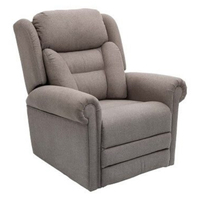
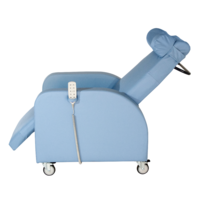
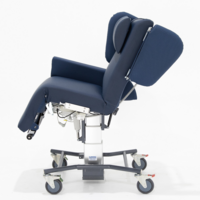
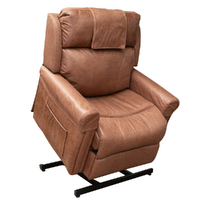
One of the most basic yet essential human actions is drinking, whether it's a morning coffee, afternoon tea, or just water to stay hydrated. For arthritis sufferers, the simple act of holding a cup or mug can be a source of discomfort due to the grip required. Thankfully, adaptive cups and mugs have been developed with these challenges in mind.
Ergonomic Handles: These mugs come with broader, contoured handles, offering a more natural and comfortable grip. Some handles are designed in a loop form, allowing the user to slide their hand in, distributing the weight more evenly.
Weighted Bottoms: To prevent accidental tipping or spills, some adaptive mugs are designed with a weighted bottom. This offers stability, especially beneficial when reflexes might be slower due to arthritis.
Spill-Proof Lids: Spills can be both frustrating and hazardous. Many adaptive cups come with spill-proof lids, which can be especially useful when hand tremors accompany arthritis.
Nosey Cups: These are uniquely designed cups with a cut-out section opposite the handle, allowing the user to drink without tilting their head back significantly. This is helpful for those with neck arthritis or those who might have difficulty swallowing.
Insulated Layers: Holding a very hot beverage can exacerbate the pain for some arthritis sufferers. Cups with insulated walls ensure that the external temperature remains comfortable to hold, while the beverage inside stays hot.
Straw Attachments: Some adaptive mugs come with built-in straw holders, allowing users to sip their drink without needing to lift the mug, reducing the stress on wrist and hand joints.
Incorporating adaptive cups and mugs into daily routines can make the act of drinking, often taken for granted, a much more enjoyable and pain-free experience for arthritis sufferers. These tools, combined with the other aids for daily living outlined above, offer a comprehensive approach to managing daily tasks with reduced discomfort, empowering those with arthritis to lead more independent and fulfilling lives.
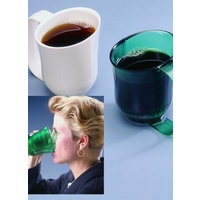
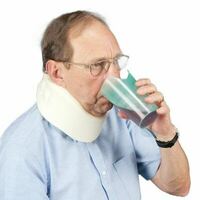
Often called "grabbers" or "reachers," are tools designed to extend an individual's reach and grip. For those with arthritis or other mobility-restricting conditions, these aids can be immensely beneficial. Here are some of the advantages of using reaching aids for arthritis sufferers:
Reduced Joint Strain: Much like the long-handled sponges, reaching aids reduce the need to stretch, bend, or reach, thereby preventing strain on the painful joints, especially the knees, back, and shoulders.
Increased Independence: Arthritis sufferers can maintain greater independence in their daily activities with the help of reaching aids, as they can grab objects without relying on others.
Safety: Bending down or reaching high can pose a risk of falls, especially on slippery surfaces. A reaching aid minimizes this risk by allowing users to retrieve items without altering their stance dramatically.
Improved Grip: Arthritis can weaken hand grip, making it difficult to hold onto objects. Reaching aids typically have a trigger handle and a jaw-like end, which can securely grasp items, preventing them from slipping.
Extended Reach: Beyond just vertically, these aids can help reach objects that are horizontally distant, such as something across a table or bed.
Reduced Fatigue: Continuous bending and reaching can tire out someone with arthritis quickly. With a reaching aid, they exert less effort and energy.
Protective: For those with conditions like osteoporosis, in addition to arthritis, even a minor fall or excessive bend can lead to fractures. Using reaching aids can be protective in such cases.
Versatile Utility: Many reaching aids come with magnetic tips for picking up small metal items or hooks to aid in dressing, making them versatile tools for various tasks.
Increased Range: For those with severely restricted mobility, reaching aids can significantly expand the range of accessible items and spaces in their environment.
Ergonomic Design: Modern reaching aids are designed with the user's comfort in mind. They often have padded handles and are lightweight to ensure ease of use even with limited hand strength.
Preserving Dignity: Simple tasks like picking up a dropped item can become major challenges with arthritis. A reaching aid can help maintain an individual's dignity by allowing them to perform such tasks without assistance.
Adaptable: Some reachers are foldable or adjustable in length to adapt to different situations and storage needs.
Arthritis can greatly hinder one's ability to perform routine tasks, making tools like reaching aids invaluable. Such devices can enhance the quality of life, promote safety, and provide a sense of autonomy for those battling the challenges of arthritis.
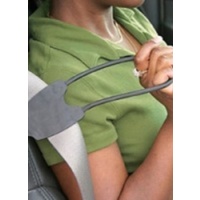
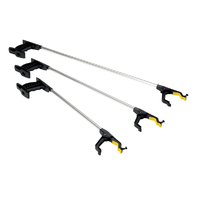
In conclusion
Arthritis, while challenging, doesn't have to dictate one's life. Through the incorporation of aids for daily living, those with arthritis can reclaim their independence and engage in activities they love with reduced pain. Embracing these tools is not just about alleviating physical pain; it's about nurturing mental well-being, ensuring that the condition doesn't overshadow life's joys. If you or a loved one suffers from arthritis, consider exploring these aids — they could be the bridge to a more comfortable, fulfilling life.
Thank you for trusting this blog as a source of information. Stay proactive, but never hesitate to reach out to a healthcare professional with any questions or concerns.